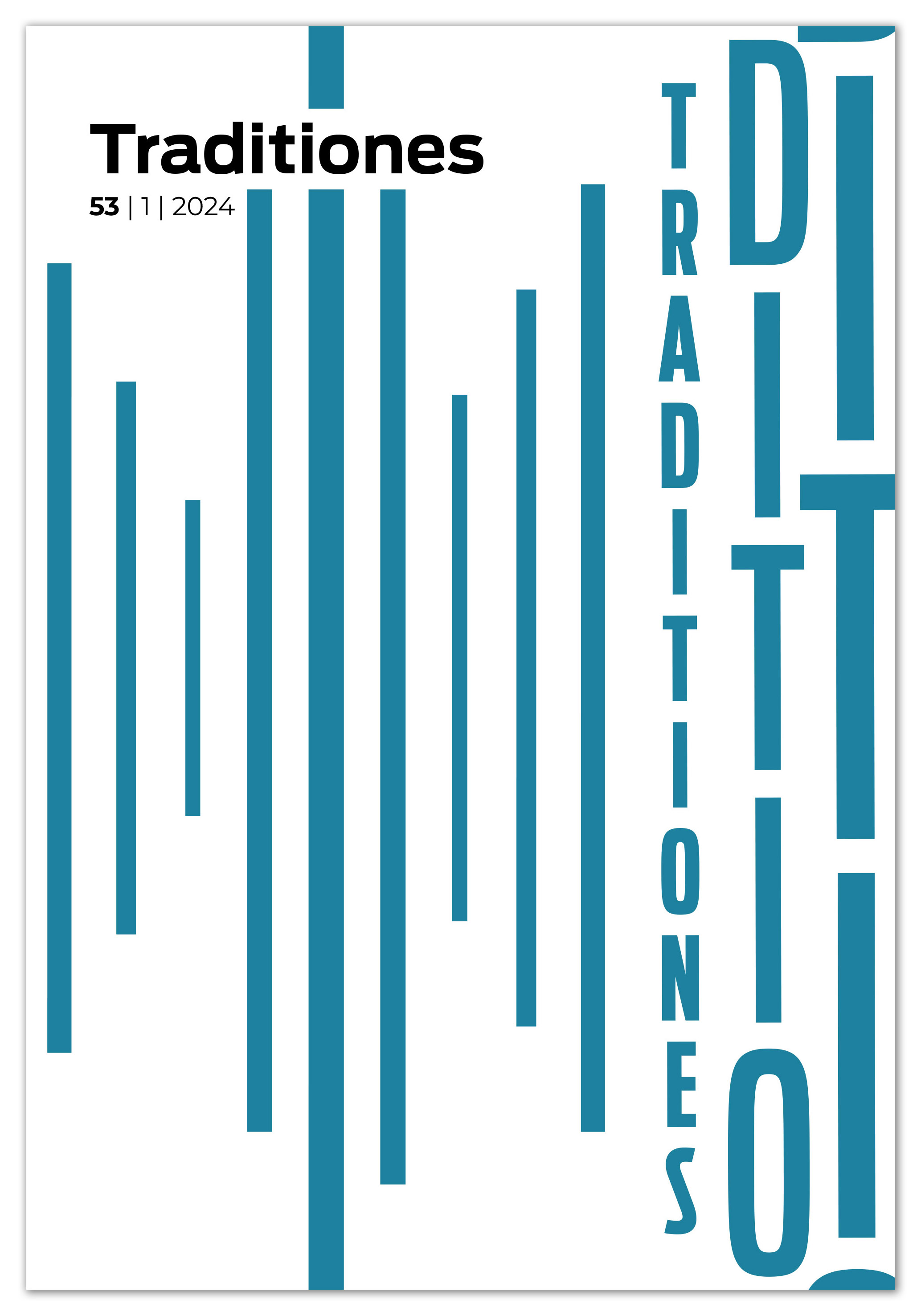Živali kot stereotipizacijski in karakterizacijski element v slovenskih poimenovanjih
DOI:
https://doi.org/10.3986/Traditio2024530104Ključne besede:
etnolingvistika, folklorni obrazci, jezik, vzdevek, živalPovzetek
Članek obravnava zakoreninjene jezikovne primerjave kot stereotipne podobe v obliki vzdevkov. Zelo pogost element teh primerjav so živali kot bitja s svojimi značilnostmi, ki s človekom živijo v skupnem okolju: človeška lastnost se primerja s predpisano, a ne nujno intrinzično lastnostjo posamične živali. Živalim pripisane lastnosti so družbeno stereotipne in se kot posplošene podobe razširjajo v metaforičnem jeziku in ustvarjajo t. i. kolektivne simbole.
Prenosi
Literatura
Agamben, Giorgio. 1998. Sovereign Power and Bare Life. Stanford: Stanford University Press.
Babič, Saša. 2015. Beseda ni konj. Estetska struktura slovenskih folklornih obrazcev. Ljubljana: Založba ZRC, ZRC SAZU. DOI: https://doi.org/10.3986/9789612547660.
Babič, Saša et. al. 2023. Collection of Slovenian Paremiological Units Pregovori 1.1. Slovenian language resource repository CLARIN.SI. Online: http://hdl.handle.net/11356/1853.
Babič, Saša. 2024. What Is Proverbial Dog Like? In Standing on the Shoulders of Giants: A Festschrift in Honour of Wolfgang Mieder on the Occasion of His 80th Birthday, eds. Saša Babič et al., 561–576. Osijek: Faculty of Humanities and Social Sciences, Josip Juraj Strossmayer University of Osijek.
Crist, Eileen. 1999. Images of Animals. Philadelphia: Temple University Press. DOI: https://doi.org/10.2307/j.ctt14bst6x.
Dąbrowska, Anna. 2023. Levels of Schematicity in Metaphorical Animal Nicknames: The Case Study of Koczkodan Nickname in Polish. Roczniki humanistyczne 71 (6): 39–62. DOI: https://doi.org/10.18290/rh23716.3.
Deignan, Alice. 2008. Corpus Linguistic Data and Conceptual Metaphor Theory. In Confronting Metaphor in Use: An Applied Linguistic Approach, eds. Mara Sophia Zanotto, Lynne Cameron, and Marilda C. Cavalcanti, 149–162. John Benjamins Publishing Company. DOI: https://doi.org/10.1075/pbns.173.
Gibbs, Raymond W. Jr. 1996. Why Many Concepts Are Metaphorical. Cognition 61 (3): 309–319. DOI: https://doi.org/10.1016/S0010-0277(96)00723-8.
Golež Kaučič, Marjetka. 2015. Zoofolkloristics: First Insights towards the New Discipline. Narodna umjetnost 52 (1): 7–30. DOI: https://doi.org/10.15176/vol52no101.
Golež Kaučič, Marjetka. 2023. »Človek je najhujša zver«. Živali v folklori, literaturi in kulturi. Ljubljana: Založba ZRC, ZRC SAZU.
Gura, Aleksandr [Гура, Александр]. 1997. Символика животных в славянской народной традиции [Animal Symbolism in Slavic Folk Tradition.] Moscow: Indrik.
Hasan-Rokem, Galit. 1974. Riddle and Proverb. The Relationship Exemplified by an Aramaic Proverb. Proverbium 24: 936–940.
Ingold, Tim, ed. 1994. What Is an Animal? One World Archaeology. London, New York: Routledge.
Jakop, Nataša. 2014. Živali v pragmatičnih frazemih: na primeru slovenščine. In Životinje u frazeološkom ruhu. Zbornik radova s međunarodnoga znanstvenog skupa Animalistički frazemi u slavenskim jezicima održanog 21. i 22. III. 2014. na Filozofskom fakultetu Sveučilišta u Zagrebu, ed. Ivana Vidović Bolt, 153–163. Zagreb: FF Press. DOI: https://doi.org/10.17234/9789531755139.11.
Kövecses, Zoltán. 2015. Where Metaphors Come From: Reconsidering Context in Metaphor. New York: Oxford University Press. DOI: https://doi.org/10.1093/acprof:oso/9780190224868.001.0001.
Krek, Simon et al. 2019. Corpus of Written Standard Slovene Gigafida 2.0. Slovenian language resource repository CLARIN.SI. Online: http://hdl.handle.net/11356/1320.
Kropej, Monika. 2007. Lisica. Njena vloga in sporočilnost v slovenskem in srednjeevropskem izročilu. Traditiones 36 (2): 115–142. DOI: https://doi.org/10.3986/Traditio2007360206.
Kropej Telban, Monika. 2015. Tipni indeks slovenskih ljudskih basni. Živalske pravljice in basni. Ljubljana: Založba ZRC, ZRC SAZU. DOI: https://doi.org/10.3986/9789612547707.
Kržišnik, Erika. 2005. Frazeologija v luči kulture. 41. seminar slovenskega jezika, literature in kulture 27. 6. 2005 – 15. 7. 2005. Zbornik predavanj, ed. Marko Stabej, 67–81. Ljubljana: Filozofska fakulteta Univerze v Ljubljani.
Lakoff, George. 1992. The Contemporary Theory of Metaphor. In Metaphor and Thought, ed. Andrew Ortony. Cambridge: Cambridge University Press.
Lakoff, George and Mark Johnson. 1980. Metaphors We Live By. University of Chicago Press.
Lévi-Strauss, Claude. 1974. Structural Anthropology. New York: Basic Books.
Lippmann, Walter. 1961 [2022]. Public Opinion. New York: The Macmillan Company.
Lockwood, Randall. 1989. Anthropomorphism Is Not a Four-Letter Word. In Perceptions of Animals in American Culture, ed. R. J. Hoage, 41–56. Washington: Smithsonian Institution.
Omakaeva, Ellara, Viktoriya Ochirova, Zhanna Chedzhieva, Galina Bovaeva, and Tatyana Buraeva. 2019. Zoomorphic Code of Culture in Reflexion of Kalmyk and Mongolian Proverbs. The European Proceedings of Social & Behavioural Sciences: International Scientific Conference “Social and Cultural Transformations in the Context of Modern Globalism 2019, eds. Dena Karim-Sultanovich Bataev et al., 2529–2535. Future Academy. DOI: https://doi.org/10.15405/epsbs.2019.12.04.339.
SSKJ: Slovar slovenskega knjižnega jezika, druga, dopolnjena in deloma prenovljena izdaja. 2014. URL: https://fran.si/133 (accessed 23.2.2023).
Schaff, Adam. 1984. The Pragmatic Function of Stereotypes. International Journal of the Sociology of Language 45: 89–100.
Šrimpf Vendramin, Katarina. 2019. “Medanc Podklanc je figo zagledal, je mislil, da je žganc”. Oblike, vsebina in funkcija medkrajevnega zbadanja na Slovenskem. Glasnik Slovenskega etnološkega društva 59 (2): 92–102.
Thompson, Tok. 2019. Post Human Folklore. Jackson: The University Press of Mississippi.
Visković, Nikola. 1996. Životinja i čovjek. Prilog kulturnoj zoologiji. Split: Književni krug.
Prenosi
Objavljeno
Kako citirati
Številka
Rubrike
Licenca

To delo je licencirano pod Creative Commons Priznanje avtorstva 4.0 mednarodno licenco.
Avtorji jamčijo, da je delo njihova avtorska stvaritev, da v njem niso kršene avtorske pravice tretjih oseb ali kake druge pravice. V primeru zahtevkov tretjih oseb se avtorji zavezujejo, da bodo varovali interese založnika ter da bodo povrnili morebitno škodo.
Podrobneje v rubriki: Prispevki






